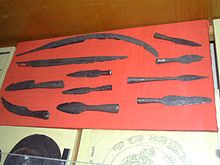Falx
| Falx | |
|---|---|
|
|
|
| Information | |
| Weapon type: | sword |
| Use: | Foot troop weapon |
| Working time: | about 100 BC Until about 300 AD |
| Region of origin / author: |
Dacia |
| Distribution: | Dacia , Roman Empire |
| Overall length: | 50 to 130 centimeters |
| Handle: | Wood, horn, bone |
| Particularities: | was modified by the Romans as Falx muralis (wall sickle), or Falx navalis. |
| Lists on the subject | |
Falx ( Latin ) was the name of the Romans for sickles and sickle-shaped tools or weapons .
Dacian falx
Falx was the Roman name for a typical cutting weapon used by the ancient Dacians . It is about 50-130 cm long curved sword with an inward curvature and a long wooden shaft, which was ground on the inside and was wielded with both hands.
In the wars of the Roman Empire against the Dacians under Decebalus in 106 AD, this weapon spread fear and terror among the Roman legionaries due to its force. A falx, led by a strong man, could cut through leather and even light iron armor and helmets. For this reason, the Romans reinforced the armor of their legionaries during Trajan's Dacia campaign. For example, cross-shaped metal struts on the dome of legionnaires' helmets are known from finds from this period , which were introduced by the armories of the Roman hawser within a short time for the legions in Dacia.
A similar weapon as the Dacian falx was the rhomphaia the Thracians .
Roman weapons
The falx muralis (wall sickle) was used by the Romans during sieges to tear down walls and other fortifications. It consisted of a long rod with a crescent-shaped, curved iron end.
The falx navalis consisted of a sharp knife attached to a long pole with which one could cut the sails and ropes of enemy ships. This tool and its use is described by Caesar in De bello Gallico as a new development and compared in its form with the already known Falx muralis.
literature
- Peter Connolly: The Roman Army. Tessloff, Nuremberg 1996. ISBN 3-7886-0745-9
Web links
Individual evidence
- ^ Caesar: De Bello Gallico, third book , Latin original
